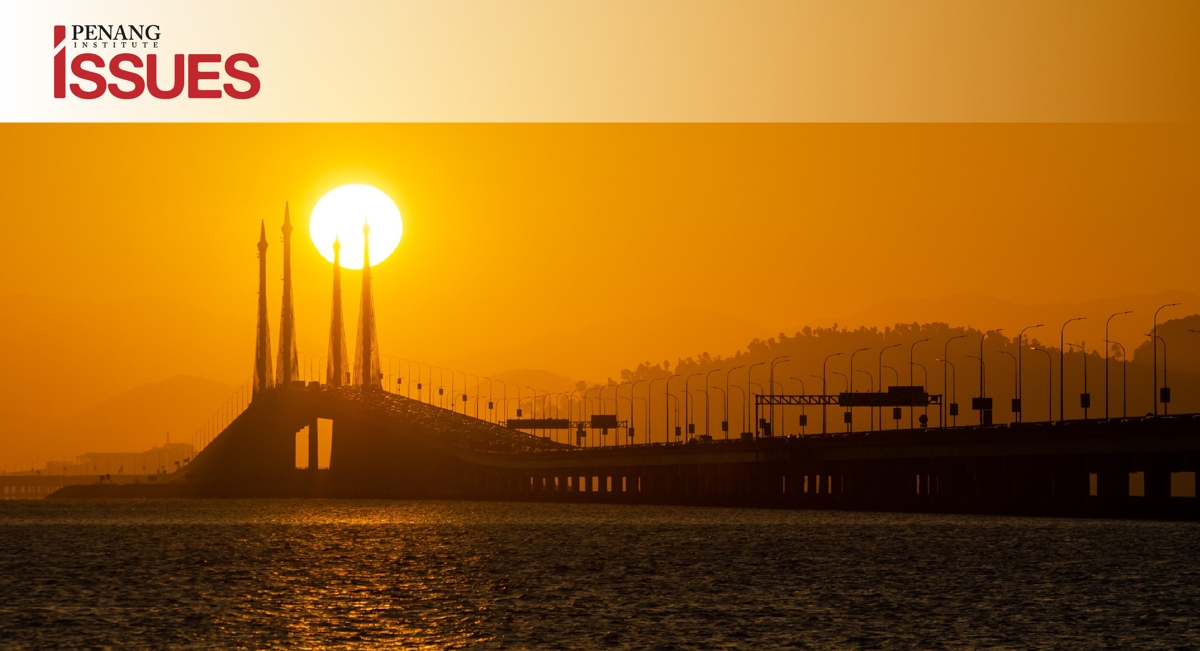[Rapporteur Notes] Penang Economic Summit 2022: The Post-Pandemic Economic Reset

Image source: tsyew
PREAMBLE
This document records main discussion points from the Penang Economic Summit 2022: The Post-Pandemic Economic Reset, organised by Penang Institute and Enterprise Asia, and held on 20 October 2022 at Setia SPICE Convention Centre, Penang. The conference gathered academics, policymakers and industry leaders to raise critical global economic issues that are expected to shape new growth areas and investment opportunities in the post-pandemic era.
Welcoming Address: Tan Sri Dr. Fong Chan Onn, Chairman of Enterprise Asia
The year 2022 is about rebuilding economies after the Covid-19 pandemic while grappling with new political and economic challenges and resurgent nationalism. Heavy government spending on infrastructure after the Second World War brought a period of economic growth. That growth was primarily driven by innovations in finance and automation technology, and international cooperation/agreements. Taking history as a guide, business innovation and international and regional cooperation are the two key ways for resetting the economy post-pandemic.
Opening Address by The Right Honourable Tuan Chow Kon Yeow, Chief Minister of Penang
The post-pandemic economy is heading to a slow recovery due to ongoing global political and economic tensions. While this is beyond its control, Malaysia should reposition itself by strengthening its economic fundamentals to boost exports and foreign capital investments and improve production to curb inflation.
Given that Penang is highly connected to the world, businesses need to make bold decisions by leveraging the opportunities brought about by global economic headwinds. Echoing Professor Ha-Joon Chang’s advice, it is important to implement industrial policies that enhance value creation and innovation-driven entrepreneurial activities.
Penang’s macroeconomic indicators are showing signs of recovery, with its GDP achieving the highest growth among Malaysian states in 2021, at 6.8%. External trade improved tremendously for the first half of 2022, with trade surplus increasing by 13%. Its export value made up 29.2% of the country’s exports. The labour market has remained resilient, with lower unemployment rates in the second quarter of 2022 and higher labour force participation rate.
Penang state initiatives have been taken to attract more workers nationwide such as the Penang Internship Subsidy Programme (PISP), the affordable housing scheme and the Penang Future Foundation.
To raise the overall well-being of society, Penang2030 programmes are seeking to improve quality of life through placemaking initiatives, community-building projects and industry engagement. Other programmes that aim to improve the livelihoods of Penang residents include the Penang Transport Master Plan (PTMP) and Penang Digital Master Plan (PDMP), where collaboration between the state and federal governments is particularly needed.
Session 1: Global Economic Outlook: Opportunities and Challenges
A Penang Perspective (YAB Chow Kon Yeow)
Penang’s Macroeconomic Indicators
Most macroeconomic indicators for Penang, which is highly connected to the world through investment, trade, and tourism, show healthy signs of recovery. Penang’s GDP grew at 6.8% in 2021, the highest in Malaysia that year. The unemployment rate in the second quarter of 2022 has fallen to 2.9% while manufacturing investment and external trade grew significantly in 2021.
Penang2030 Vision
The Penang State Government is implementing strategic initiatives in Phase Two of its Penang2030 programme. These are in placemaking, community-building and industry engagement; the state is also intensifying efforts to drive the sustainability agenda forward.
Strong Presence in the Electrical and Electronics (E&E) Industry
Manufacturing in Penang is driven by Multinational Companies (MNCs) and global trade. Its role in the electrical and electronics (E&E) sector is globally strong. This industry is of great assistance to the continued growth of adjacent industries.
Tourism
The pandemic has affected the services and tourism sectors tremendously. However, tourism industry in the state has been recovering rapidly following the reopening of domestic and international borders. The need for improvement in the standard of services provided in this sector to grow the Penang tourism industry has also been recognised as a matter of strong urgency.
Overall, Penang realises the need for indigenous growth (deepening backward integration between MNCs and local firms) and diversification to reduce economic risks in the future. Despite the dependency of Penang on the semiconductor industry, trade tensions between the US and China and geographical factors have created opportunities for Penang to remain a semiconductor manufacturing hub.
A Malaysia Perspective (Dr. Nungsari Ahmad Radhi)
Three main challenges faced by Malaysia’s economy today are:
1. Investment and domestication of Malaysia’s economy;
2. Income inequality, and;
3. Sovereign and fiscal risks.
Investment and Domestication of Malaysia’s Economy
The disconnect between the monetary side of the economy and the real side of the economy is growing. Malaysia’s economy is focused and dependent on the domestic market, and most of the services offered by local firms are low-end and non-tradable services. This situation creates risks and also affects investments in this country.
Income Inequality
Renormalization of the monetary policy causes problems. Wage is growing slower in most states, where the individual median wage is above RM2,000 and the household median wage is only around RM6,000. This situation affects the formation of firms and investment in the country and its progress towards achieving high-income status.
Sovereign and Fiscal Risks
Bank Negara Malaysia is increasing the interest rate following the steps taken by the US Federal Reserve. This causes an increase in the cost of borrowing. Malaysia’s government revenue is only sufficient to cover operation expenditures, whereas development expenditures have increased to around RM90 billion and are covered through borrowing.
Political Situation
The political situation in Malaysia is still equilibrating. Malaysia held a general election in November 2022. This election hopes to create political stability in this country. However, Malaysia may require a longer time to create political stability even after the 2022 general election.
Malaysia needs to strengthen its local economic fundamentals by capitalising on the weakened Ringgit. Policies for export boosting, conducive foreign capital investment provisions, and production supply are needed to improve export, attract investment, and tackle inflation. The country needs to create employment opportunities that are not dependent on domestic demand. Local firms should be more competitive in the global market, and Malaysia should focus on leveraging the regional market.
A Global Perspective (Professor Danny Quah)
There are three main challenges to the world’s economy today. These are deglobalisation, geopolitical tensions, and techno-nationalism. Others include global recession and rising inflation are other challenges encountered by the world at present.
Deglobalisation
Deglobalisation is well set in place and will be difficult to dislodge. At the same time, the global response to the pandemic remains disorganised and disparate. The global climate crisis calls for urgent changes in economic lifestyle, economic production, and energy transition; however, the world is not yet ready for this new era. The world sees danger in centralisation and concentration of key traction points in the production process of the global economy. The prime industry for such concentration is semiconductor and computer chips, with its advanced semiconductor producers saturated in Taiwan, South Korea, and the US. This has caused the global economy to be fragile and non-resilience
Geopolitical tensions
Great power competition or zero-sum competition has intensified. The trade tension between the US and China leaves nations around the world navigating a fractured landscape, putting the world in a dangerous situation. Healthy competition occurs when we invest in good infrastructure and education for economic development, in contrast to security competition where we contain competitors’ contribution by keeping them from achieving their full potential.
Techno-nationalism
Technology may have contributed to economic prosperity; however, it has now been weaponized. The nation that controls the technological frontier has the greatest economic power. Simultaneously, those without this capability, aim to deprive the rest of the world of that knowledge and capacity. This situation has positioned the world at risk.
Global Recession and Inflation
Based on the economic situation in the three largest economies in the world (i.e. the US, China and Europe), the world is edging toward a global recession in 2023. The ongoing geopolitical challenges, the war in Ukraine and the trade tension between the US and China put the world’s economy in a state of uncertainty. The tight monetary policy undertaken by the US Federal Reserve to tackle inflation by increasing the interest rate in their country should contribute to recession.
In conclusion, there is no clear and quick resolution to the global headwinds. Nevertheless, there are opportunities for Penang, Malaysia, and South-East Asia to grow through the utilisation of human capital and entrepreneurship. Besides the issues discussed, rising inflation also needs to be addressed.
Session 2: Sustainability and Shared Values as Economic Game Changers
Keynote Speech by Dr. Allinnettes Adigue, Head of the ASEAN Regional Hub of Global Reporting Initiative
Global Reporting Initiative (GRI) focuses on four areas: creating and maintaining world-class sustainability disclosure standards, driving global adoption of the GRI standards, improving the quality of reporting, and supporting full public access to sustainability disclosures.
The economy depends on natural resources, and sustainability is important for the economy because, after all, there is no business on a dead planet. The ability of organisations and businesses to integrate sustainability into their operations or DNA will be a major challenge.
Sustainability cannot happen in isolation; it requires a coordinated approach from businesses, financial institutions, and governments. Governments need to implement the right policies and financial sectors need to ensure capital acts for the long term. Also, businesses have to align their goals and business models and maintain evidence-based targets.
Sustainability can be realised when profit is made from solving environmental and social problems, rather than from externalising social and environmental factors.
Session 3: The Future of Manufacturing
The manufacturing sector is the key driver of economic growth in Penang. Concerns have been raised about whether the sector has reached its peak with the presence of the digital economy. To be sure, digitalisation has seen the emergence of new phenomena, such as the gig economy, e-commerce, high-end services, amongst others
Digitalisation has improved the value chains of manufacturing industries by contributing to efficient production processes, creating more sophisticated products, and improving the competitiveness of the firms. For instance, Keysight Technologies Malaysia applies automation to improve its operations and outputs. Digitalisation assists firms in supply chain management by enabling them to identify issues and solutions faster.
Digital technology has also transformed how human beings live, work, and interact. For example, people nowadays read articles, newspapers and books digitally. Intel plans to set up two manufacturing centres in Penang that will produce Advanced Packaging Technology (Moore’s Law).
Malaysia, especially Penang, attracts foreign direct investment (FDI) due to geographical factors. In addition, good infrastructure would further attract talent and investment. For example, companies such as Lam Research in Penang intends to implement what is known as ‘The Semiverse’. This will create greater opportunities for innovation and disruptive ideas by allowing different parties to collaborate and study various ideas and simulations in economical and effective ways. The ‘Semiverse’ needs a good place to become tangible. Thus, a good location and effective human capital will play a crucial role in its success.
The convergence of technology will lead to transformation in most industries, especially manufacturing sectors, in the coming decades. Manufacturing companies, therefore, seek to integrate technology into their organisations to enhance business operations. Berjayapak, for example, concentrates on technology advancement in four areas—material, manufacturing processes, information systems, and Supply Chain Management systems. It produces alternative materials, uses automation and mechanisation, implements the Human Resource Information System (HRIS) and Customer Relationship Management (CRM), and monitors the supply chain. It also participates in global forums to be well-informed about current technology.
Intel, one of Penang’s leading semiconductor manufacturers, believes that a robust supply chain is needed – broader, accessible, and reliable in the face of geopolitical conflicts. Foreign direct investment (FDI) and a robust supply chain are critical for ensuring the manufacturing industry’s long-term viability through digitalisation. Furthermore, collaboration between the state, industry and academia is vital to nurture the required skills.
Global supply chain resilience has become a key issue. Keysight Technologies Malaysia, therefore, updates and reviews its role on this issue regularly, using several strategies to reduce risks such as being reliant on a single source.
The future of manufacturing, which will be driven by the next wave of digital technologies further sees changes in supply chains, design and production processes. After the pandemic, businesses are expected to adapt and gain new momentum by changing the landscape of the manufacturing sector.
Session 4: How Will Technology and Innovation Transform Tourism, Logistics and Healthcare?
Transforming Tourism, Logistics and Healthcare
Tourism
For many years, tourists have been facing issues related to inconsistent commission payments for services provided by hotels, transportation (taxis), theme parks, etc.) Through digital innovation, Sim Leisure Group addresses this issue by improvising its online ticketing system – which was created 10 years ago. This innovation features paperless tickets, Digi photo finders, cashless transactions, and tracking elements. This online ticketing system has strengthened during the post-pandemic, improving customer satisfaction and travelling experience. Moving forward, Sim Leisure Group also plans to market this innovation globally.
Logistics
Exabytes Group developed ‘Food Bank Digital’ during the pandemic. This innovation is an integration of e-commerce, logistics and fulfilment capabilities, and assists households that need assistance (basic needs such as food). Through ‘Food Bank Digital’, Exabytes Group supports vulnerable groups by focusing on delivery services, and believes that this initiative helps the country cope with the pandemic.
Healthcare
People are dying every day in Malaysia from heart disease. IHeal focuses on reducing this number by developing a ‘Pocket Doc’, an application for virtual emergency care visits. This innovation allows early detection of potential heart attacks. Interactions between patient and physician involving consultation, test procedures and treatment can be assessed virtually as instructed online by the physician. ‘Pocket Doc’ shows that technology is transforming the healthcare industry.
Challenges Associated with Digital Transformation in These Sectors
Digital Infrastructure
Digital Infrastructure is among the challenges faced by these industries. It is important to highlight
that a stable internet connection is key to the successful digitalisation and transformation of the travel and tourism industry. Paperless tickets, digital tour guides and virtual recreations cannot be implemented efficiently if good internet access and network are not in place. Therefore, continued efforts in upgrading the digital infrastructure of the state is urgently needed.
Data Privacy
Data privacy is still the main challenge in digital transformation, especially in the healthcare sector. Patients are concerned about how data security is managed. Data hoarding, data trading, and vulnerability of the data are issues that need to be addressed by the industry. Thus, physicians should be capable of managing patients’ data to gain (patients’) trust. In addition, organisations should assume new roles to drive value in a transformed health ecosystem, and work together to increase efficiency, improve healthcare experiences and deliver care more equitably.
Way of Thinking
A digital mindset is an important component in digital transformation. The unwillingness of organisations and firms to embrace new technology is an example of the challenges faced, especially in the tourism industry.
The future of logistics is undoubtedly going to be digital, but it will also be flexible, agile, versatile, distributed across regions, and truly open. In reaction to the changes, logistics providers should look into new avenues of growth to reduce concentration risks and interruptions brought on by occurrences such as health pandemics or geopolitical unrest.
Leadership, management and talent also play important roles. Thus, organisations need good leadership informed by a digital mindset and good management practices. While technology and innovation cannot replace the physical travelling experience, it can enhance tourists’ satisfaction and experience.
Session 5: Laying the Foundations for a Digital Future
Humans, machines, and the environment are key concerns in the digital era. Genomics, such as the development of new vaccines, for example, will grow significance in the future. Material technology is showing an inclining trend, while the environment has become hyper-connected with the Internet of Things (IoT), and sensors will be widespread. Four key elements shaping the digital future are digital mindsets, digital talent, digital infrastructure, and cyber security.
Digital Mindsets
Profit-oriented firms use technology to enhance operations and increase revenues. To go digital, the mindset of founders and owners plays a critical role. They need to be more competitive and enthusiastic about digital transformation, especially those in small and medium enterprises (SMEs). Culture also determines digitalisation. The general public needs to incorporate technology into their daily lives for a digital market to be viable. For example, e-wallet utilisation in society is still low, especially among the elderly.
Digital Talent
Digital talent is needed in healthcare, tourism, and manufacturing sectors, particularly in data analytics, network analytics, and cloud computing. Currently, Malaysia faces a shortage of information & technology (IT) talent, particularly in Penang, where economic growth is strong. Much of the national supply of IT talent is migrating and working overseas.
Developing existing and future talent poses a great challenge for the country. More digital talent is needed in the areas of artificial intelligence (AI), machine learning, and big data analytics.
Digital Infrastructure
Infrastructure is key. The digital future cannot exist without more robust and resilient infrastructure, and technology itself is dependent on physical systems. The government should play its role in creating opportunities and an environment that supports digital transformation.
For example, cities in China have welcomed ‘China Mobile’ to build digital infrastructures with fewer restrictions, such as no rental fees charged for building infrastructure in the cities. Penang, as a digital hub, also welcomes data centre investments. Digital Penang believes that fewer regulatory constraints will attract digital investment to the country.
Cyber Security
Cyber threats are inevitable and they do not occur only in information technology, but in operational technology as well. These can cause operational disruptions, reputational damage and loss of revenue. Therefore, measures need to be taken to reduce the risks of cyber-attacks. Being well-informed on cyber threats, ensuring the availability of cyber security experts, building capacity locally, and reducing dependency on outside experts are among the measures taken to address this issue. For example, Celcom Axiata Berhad in Petaling Jaya monitors cyber threats and keeps the organisation well-informed on digital risks.
Session 6: The Great Resignation and the Way Forward
The Great Resignation is a term explaining an event where 4.2 million employees resigned from their jobs in the US in October 2021 amounting to three percent of its labour force. Since most employees prefer flexible jobs, better income and greater job satisfaction, The Great Reshuffle is considered a more appropriate term.
Key Challenges
Talent Market Expectations
Talent market expectations have changed post-pandemic. The demand for remote working, flexible and hybrid working arrangements are on the rise, including among new recruitments. While most job seekers request work-life balance arrangements, only a small number of employers are able to offer these benefits.
These arrangements are less applicable to manufacturing industries. This situation has caused some employees who demand flexible work arrangements to resign, contributing to the mass turnover.
Demand and Qualitative Mismatch
There are less applications per job in Asia despite more jobs being available after the pandemic. According to JobStreet, labour force participation and job opportunities have increased. However, requirements sought by employers after the pandemic are generally similar to pre-pandemic times, with only IT skills being additional sought-after skills. There is a hiring gap where job seekers are more interested in taking flexible job arrangements and/or childcare benefits.
Skills mismatch has been a longstanding issue observed by the industries. Policymakers need to work closely with the private sector to map out the skills gap in the workforce.
The Millennials
Millennials look for learning opportunities in the organisation that they are interested in joining. For example, UST found that this generation of workers wants to learn about the latest technologies such as 5G and the Internet of Things (IoT). They also wish to learn how to create, integrate and connect these applications. Providing learning and hands-on involvement opportunities are keys to attracting and retaining talent, especially the millennials.
Suggested Measures
Well-being of Employees
The well-being of employees needs to be considered more seriously to reduce turnover rates in an organisation. Micron, for example, provides meals assistance and a childcare centre to employees regardless of job position. In addition, full-time counsellors and well-being specialists are available to assist workers concerning their well-being and health.
Learning Opportunities
Career development opportunities such as quality of work, global learning opportunities, and involvement in niche projects are good indicators of employee retention. Due to the demand for a fast-learning curve and ad-hoc technological change among the millennials, UST, a global company, strives to provide such opportunities for employees to become tech-savvy at the same rate as the organisation’s efforts.
Workplace Culture
Other factors influencing the ability of employers to retain employees include organisational culture. For example, Micron builds a positive and appealing workplace culture in its organisation to excite employees, especially millennials.
Closing Remarks
by YB Dato’ Haji Abdul Halim bin Haji Hussain, Penang State EXCO for Trade, Industry and Entrepreneurship Development
Penang Economic Summit 2022 is important for policymakers to facilitate and obtain feedback from the industries. The pandemic has highlighted the need for public-private-people partnerships in achieving common goals.
It is important for policymakers to always have a desire for continuous learning. To improve the country’s development to the next level, collaboration and coordination between state and federal agencies, public and private sectors, civil society and policymakers are crucial.
The E&E sector will remain a core growth driver for Penang’s economy. Penang has a talented workforce built over the last five decades, and the manufacturing ecosystem has made the state the country’s leader in the sector. Technology and innovation in the manufacturing sector need to be sustained along with other growing sectors such as the non-semiconductor industries, medical tourism, logistics, and finance. These can be significant contributors to Penang’s economy in the future.
The talent shortage remains the central issue globally, especially in the digital economy. The salary offered is not the only pulling factor in attracting talented individuals to work in Penang; environmental factors also play a role. For example, Google’s attractive work environment entices plenty of new recruits. In short, companies and organisations in Penang should take note of it and create a similar workplace environment.
Malaysia’s small and medium-sized enterprises (SMEs) can become more competitive in the global market by focusing on exports. For Penang, research and development (R&D) is needed for SMEs to grow together. This will require assistance from the federal government.
You might also like:
![Logging in Ulu Muda Forest Reserve: Is Penang’s Water Security under Threat?]()
Logging in Ulu Muda Forest Reserve: Is Penang’s Water Security under Threat?
![ESG Disclosures among Public-listed Companies Based in Penang]()
ESG Disclosures among Public-listed Companies Based in Penang
![Key Changes to Development Expenditure in Malaysia’s Budget 2019]()
Key Changes to Development Expenditure in Malaysia’s Budget 2019
![Chinese Property Projects in Southern Johor: Should We Be Concerned?]()
Chinese Property Projects in Southern Johor: Should We Be Concerned?
![Raising the Alarm: Urgent Reforms Needed to Address PISA and Propel STEM Education]()
Raising the Alarm: Urgent Reforms Needed to Address PISA and Propel STEM Education











